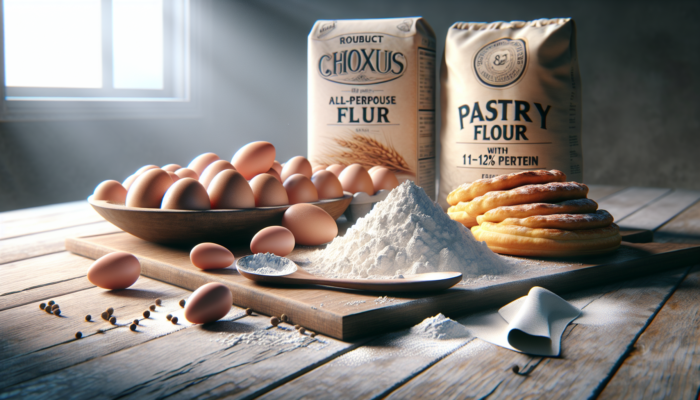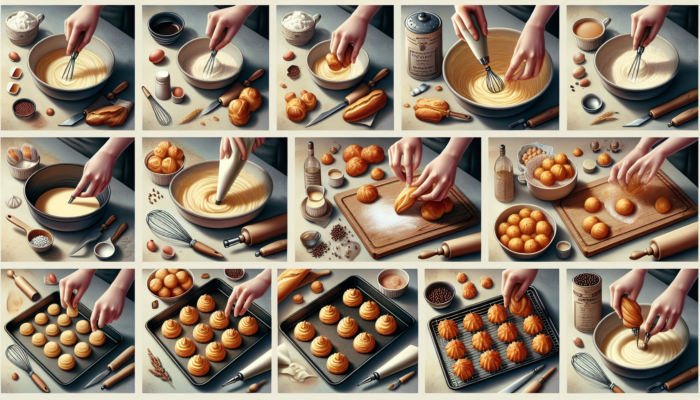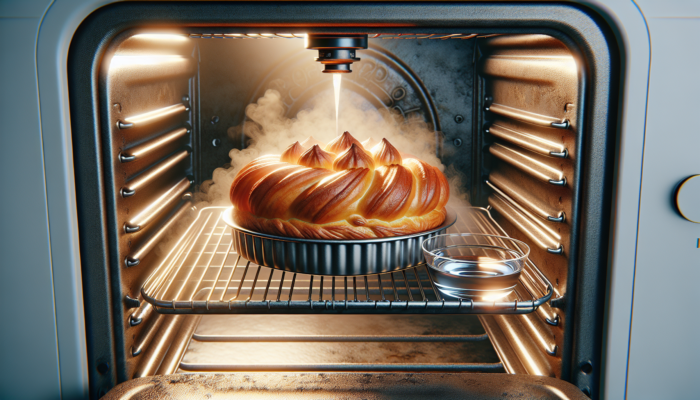Unlock the Secrets of Choux Pastry: Effective Techniques for Exceptional Baking
To truly excel in the sophisticated art of Choux pastry, one must delve into the fundamental techniques that yield outstanding culinary results. Mastery of this exquisite pastry hinges on a comprehensive grasp of high-quality ingredients, meticulous measurements, and precise temperature regulation throughout both the preparation and baking stages. These critical factors are essential for achieving the desired light and airy texture that characterizes choux pastry, making it a beloved choice for both professional chefs and passionate home bakers alike.
Choosing Top-Tier Ingredients for Flawless Choux Pastry

The success of creating a delightful choux pastry is significantly influenced by the selection of superior ingredients. At the core of this refined pastry lies the flour. It is advisable to choose a robust all-purpose flour or, when feasible, a specialized pastry flour with a protein content of approximately 11-12%. This ideal protein balance not only provides the necessary structure but also ensures a tender crumb. Avoid using cake flour, as its lower protein content may lead to a dough that lacks the strength needed to maintain its shape during baking, resulting in less than satisfactory outcomes.
Additionally, the selection of butter is pivotal in defining the flavor profile of your choux. Opting for unsalted butter is wise, as it provides better control over the pastry's salt levels. It's essential to ensure that the butter is fresh and of high quality; premium brands typically possess a higher fat content, which greatly enhances the flavor and mouthfeel of your pastry, delivering an indulgent experience.
Finally, eggs are crucial for crafting the ideal choux. Large, fresh eggs are typically the best option as they contribute vital moisture and structural support. The method of incorporating eggs is equally important; start by whisking the eggs separately, then gradually blend them into your cooked flour and butter mixture. This gradual integration is essential for achieving a smooth and glossy consistency, perfect for piping.
Nailing the Ideal Ingredient Ratios for Perfect Choux Pastry Texture
Understanding and mastering the ratios of your ingredients is imperative for achieving the perfect choux pastry consistency. Traditional recipes for preparing choux pastry typically adhere to a straightforward formula of 1:1:2:2—one part flour, one part butter, two parts water, and two eggs. This simple yet effective equation guarantees the ideal rise and texture that every baker aspires to achieve, resulting in a pastry that is both light and flavorful.
For instance, if you start with 100 grams of flour, you should also utilize 100 grams of butter and double the amount of water to 200 grams. This careful balance ensures that your pastry rises beautifully while maintaining its structure after baking, resulting in a delightful final product that is sure to impress anyone fortunate enough to enjoy it.
It’s important to understand that these ratios may require slight adjustments depending on the humidity and temperature conditions in your kitchen. In particularly warm environments, slightly reducing the amount of water or eggs can help prevent a loose dough, while cooler conditions might necessitate a tad more liquid. Trust your instincts and monitor the consistency of the dough as you mix, making adjustments as necessary for the best results.
Mastering Temperature Control for Effective Mixing and Baking of Choux Pastry
Maintaining proper temperature is essential during both the mixing and baking phases of choux pastry preparation. When cooking the flour and butter mixture, it is crucial to do so over medium heat. This technique ensures that the butter melts completely and the flour cooks without browning. The mixture should come together into a cohesive ball that pulls away from the sides of the pan—this is a clear sign that it is ready for the subsequent step in your pastry-making endeavor.
After preparing the mixture, allow it to cool slightly before incorporating the eggs. If the mixture is excessively hot, it can inadvertently cook the eggs, leading to undesirable lumps that compromise the texture. Conversely, if the mixture is too cool, it may not rise adequately in the oven. A reliable guideline is to cool the mixture to approximately body temperature before introducing the eggs.
Consistent temperature maintenance during the baking phase is equally vital. Preheat your oven thoroughly and avoid opening the door during the first half of the baking time, as this can cause the pastries to collapse. The optimal baking temperature for choux pastry is around 200°C (390°F). This elevated heat is crucial for converting the water in the dough into steam, which creates the light and airy texture characteristic of expertly crafted choux pastry.
A Comprehensive Step-by-Step Approach to Crafting Perfect Choux Pastry

Having explored essential strategies, let’s dive into a thorough step-by-step guide designed to empower you in crafting your perfect choux pastry creation. By diligently adhering to these meticulous instructions, you will be fully equipped to create the ideal choux pastry that is sure to impress everyone who tastes it.
Proven Techniques for Preparing Choux Pastry Dough
Creating choux pastry dough might appear straightforward, yet it demands meticulous attention to detail. Begin by accurately measuring your ingredients. In a medium saucepan, combine water, butter, and a pinch of salt. Bring this mixture to a gentle boil over medium heat, ensuring that the butter completely melts and the salt dissolves.
Once the mixture reaches a rolling boil, promptly remove the pan from the heat and immediately incorporate the flour. Stir vigorously with a wooden spoon or spatula until the mixture forms a cohesive ball that separates from the sides of the pan. This critical step ensures that the flour cooks properly and develops the necessary structure for your pastry, laying the groundwork for a successful bake.
Next, transfer the dough to a mixing bowl and allow it to cool for approximately five minutes. This resting period is vital to prevent the eggs from cooking upon contact with the hot mixture. Gradually add the eggs, mixing thoroughly until the dough is smooth and glossy. The final dough should fall from the spatula in a thick ribbon-like consistency. If it feels too stiff, add a bit more egg; conversely, if it’s too runny, you may need to incorporate a little additional flour to achieve the right balance.
Once your dough reaches the desired consistency, allow it to rest for at least 15 minutes. This resting phase is essential for relaxing the gluten, resulting in a more tender pastry that can rise beautifully during the baking process.
Refining Piping Techniques for Consistent Choux Pastry Shapes
Piping choux pastry is an art that profoundly influences the shape and consistency of your pastries. Begin by preparing your piping bag fitted with a round tip—typically, a 1cm (0.4 inches) plain tip is ideal for creating éclairs and cream puffs.
Fill your piping bag with the prepared pastry dough. To ensure uniform shapes, pipe the dough onto a lined baking sheet while holding the bag at a 90-degree angle. Gently squeeze the bag while lifting it to form a peak, then stop applying pressure before pulling away to avoid trailing ends that could detract from the final appearance.
For éclairs, pipe straight lines that measure about 10cm (4 inches) long, and for cream puffs, create small mounds that are approximately 4cm (1.5 inches) in diameter. To achieve a smooth finish, lightly dip your finger in water and gently smooth down any peaks left from piping. This technique will create a polished look once baked, enhancing the visual appeal of your pastries.
Ensure that you leave sufficient space between the pastries on the baking tray, as they will expand during baking. A good rule of thumb is to maintain at least 5cm (2 inches) of space between each piped piece to ensure even cooking and prevent them from merging together.
Crucial Baking Techniques for Achieving Perfect Choux Pastry

The baking process is where the true magic of choux pastry occurs. To ensure consistent rising and even cooking, preheat your oven to 200°C (390°F) and position your baking tray in the center of the oven to promote optimal air circulation.
To generate the essential steam, which is vital for the rise of the pastry, place a small oven-safe dish filled with water at the bottom of the oven. This will create a humid environment that helps prevent the pastries from drying out too quickly during the baking process, ensuring a delightful texture that is light and airy.
Avoid opening the oven door during the first 20 minutes of baking. A sudden drop in temperature can cause your pastries to collapse, leading to flat and unsatisfactory results. After 20 minutes, you can briefly check their progress. If they are rising nicely and developing a golden brown hue, you know they are on the right track toward perfection.
When the pastries are fully baked, they should appear golden and firm to the touch. Remove them from the oven and allow them to cool on a wire rack. This cooling phase is crucial to prevent sogginess; if left on the baking tray, moisture can accumulate and negatively affect the texture of your pastries, diminishing their delightful crispness.
Troubleshooting Common Choux Pastry Problems: Solutions for Success
Even seasoned bakers may face challenges while creating choux pastry. Recognizing common issues and their effective solutions is essential for mastering the secrets to achieving flawless choux pastry.
Identifying Flat Pastries: Causes and Practical Remedies
Flat choux pastries can arise from several factors. A primary cause is insufficient steam during the baking process. If your dough lacks adequate moisture or if the oven environment is overly dry, the pastries may not rise as expected. To remedy this, ensure your water-to-flour ratio is accurate, and consider adding an extra egg for additional moisture if necessary.
Improper mixing can also lead to flat pastries. If the dough isn’t mixed thoroughly after incorporating the eggs, it may become too dense, hindering the necessary lift. Always mix until the dough is smooth and glossy to ensure the light and airy texture you desire.
Moreover, it’s critical to avoid opening the oven door prematurely. A sudden temperature drop can result in collapsing pastries. It's best to wait until they have risen sufficiently before checking on them to ensure a successful baking outcome.
Preventing Soggy Bottoms in Your Choux Pastry Creations
Soggy bottoms can be a frustrating issue when baking choux. This problem often stems from either underbaking or excess moisture in the dough. To avoid this, ensure your pastries are baked until they achieve a golden brown color and feel firm to the touch, indicating they are fully cooked and ready to be enjoyed.
Using a baking sheet lined with parchment paper can also help absorb moisture effectively. If you find that your pastries remain soggy, consider returning them to the oven for additional baking time to ensure they dry out completely and achieve that perfect texture.
Another practical tip is to pierce the bottoms of the pastries with a toothpick after baking, allowing steam to escape. This technique helps prevent moisture from getting trapped inside, resulting in a crispier finish that enhances the overall quality of your pastries.
Addressing Cracking Issues During the Baking Process
Cracking in choux pastry is a common problem that can occur due to various factors. One primary reason for cracking is baking the pastries at excessively high temperatures. While a high initial temperature is crucial for rising, if it’s too high, the pastry may rise too quickly and develop cracks.
To address this issue, consider slightly reducing the temperature after the first 15 minutes of baking, allowing for a more gradual rise that helps maintain structural integrity and prevents unsightly cracks from forming.
Overmixing the dough after adding the eggs can also lead to a fragile structure that struggles to support the rising process. Mix just until combined and smooth to achieve optimal results in your pastry.
Lastly, ensure that you are using fresh ingredients. Old flour or stale eggs can adversely affect the quality of your pastry, leading to unsatisfactory outcomes that can easily be avoided with careful ingredient selection.
Advanced Techniques to Elevate Your Choux Pastry Mastery
Once you have mastered the fundamentals, it's time to explore advanced techniques that can elevate your choux pastry creations to new heights of culinary excellence.
Creating Choux Au Craquelin: A Crunchy and Flavorful Variation
Choux au craquelin is a delightful twist on traditional choux pastry, featuring a crunchy topping that enhances both texture and flavor. To prepare this variation, create a simple sugar cookie dough using equal parts flour, butter, and brown sugar.
Roll the craquelin dough into a thin sheet and cut it into smaller circles than your piped choux. Before baking, place a circle atop each piped pastry. As the pastries rise in the oven, the craquelin will spread, forming a delightful, crunchy topping that beautifully contrasts with the soft pastry beneath, resulting in a visually appealing and delicious treat that everyone will enjoy.
This technique not only adds visual appeal but also enriches the overall flavor profile of your choux creations, making them even more enjoyable to eat and share with others.
Infusing Unique Flavors into Your Choux Pastry Dough
Infusing flavors into your choux pastry dough can lead to exciting and innovative creations that will undoubtedly stand out. Consider enhancing your butter with vanilla, citrus zest, or spices like cinnamon before mixing it with the flour. These subtle enhancements can elevate your pastries, making them truly memorable for anyone fortunate enough to taste them.
Another exciting option is to incorporate extracts or flavorings directly into the dough. For example, a hint of almond extract can add a delightful twist to classic éclairs. Exercise caution with the amounts, as even a small quantity can significantly impact the overall flavor; thus, it’s best to start with a little and adjust as needed.
For a more adventurous variation, consider adding cocoa powder to your flour to create a rich chocolate choux pastry. This decadent base pairs beautifully with fillings like cream or custard, resulting in a delectable dessert that is sure to impress your family and friends.
Perfecting the Art of Decorating and Filling Choux Pastry
The final step in perfecting your choux pastry is mastering the art of decorating and filling. Classic fillings such as whipped cream, pastry cream, or custard are always popular choices for enhancing your pastries. To fill your creations, use a piping bag fitted with a small round tip. Insert the tip into the base of the pastry and gently squeeze until you feel slight resistance, indicating that it’s filled properly and ready for enjoyment.
For decoration, consider glazing your éclairs with a simple chocolate ganache or icing. A light dusting of powdered sugar on cream puffs adds an elegant touch. You might also choose to experiment with edible gold leaf or colorful sprinkles for a festive flair that enhances the visual appeal of your pastries, making them even more inviting and delightful.
Remember, presentation is paramount. Take the time to arrange your pastries artfully on a plate, and consider pairing them with fresh fruit or a berry coulis for added color and flavor contrast that is sure to captivate your guests.
Exploring the Versatility of Choux Pastry: Culinary Applications
Understanding the various applications of choux pastry can unlock a world of culinary possibilities. Here are some classic and modern uses of choux pastry that highlight its remarkable versatility and allow for endless creativity in the kitchen.
Crafting Classic Éclairs and Profiteroles Using Choux Pastry
Éclairs and profiteroles are among the most recognized forms of choux. Éclairs are long, filled pastries traditionally filled with pastry cream and topped with chocolate icing for a delightful finish. To create perfect éclairs, pipe elongated shapes onto a baking sheet. Once baked and cooled, fill them with your preferred filling and drizzle with chocolate ganache for a classic finish that delights the senses.
Conversely, profiteroles are small, round puffs often filled with whipped cream or ice cream. They can be served plain or drizzled with chocolate sauce for an indulgent treat. To create profiteroles, simply pipe small rounds and bake just as you would for éclairs. Once filled, they can be beautifully assembled into a croquembouche, creating an impressive centerpiece for any special occasion or gathering.
Transforming Choux Pastry into Delicious Churros and Beignets
Choux pastry is incredibly adaptable, allowing you to create beloved fried treats like churros and beignets. For churros, pipe the dough into hot oil and fry until they achieve a golden brown hue. Toss them in cinnamon sugar for a delightful treat that is crispy on the outside while remaining soft and tender on the inside.
Beignets, the iconic French doughnuts, can also be made using choux pastry. Pipe small dough balls into hot oil and fry until they puff up and turn golden. Dust them with powdered sugar for an indulgent dessert that will surely impress your family and friends, making for an unforgettable culinary experience.
Exploring Savory Uses of Choux Pastry in Culinary Creations
Choux pastry isn’t limited to sweet treats; it can also be utilized to craft a variety of savory dishes. Cheese puffs, or gougères, are a fantastic example. By adding grated cheese, such as Gruyère or cheddar, to your choux pastry dough before piping and baking, you create delightful savory snacks that are perfect for any occasion.
These cheesy delights make for perfect appetizers or party snacks that will impress your guests and leave them asking for more. You can also experiment by incorporating various herbs or spices into the dough, making them versatile additions to any meal and a wonderful way to elevate your culinary offerings.
Professional Insights on Mastering Choux Pastry: Learning from Experts
Gaining insights from professional pastry chefs can provide invaluable guidance in perfecting your choux pastry skills. Here are expert tips and common pitfalls to avoid on your journey to mastery.
Expert Recommendations from Seasoned Pastry Chefs
Many professional pastry chefs underscore the importance of practice in mastering choux. Renowned chefs advise starting with small batches to refine your technique before progressing to larger quantities. They also stress the necessity of patience; choux pastry can be unforgiving, and it may take several attempts to achieve the perfect puff that you envision and desire.
Another crucial piece of advice is to trust your instincts regarding ingredient ratios. While standard recipes serve as valuable guidelines, slight modifications might be necessary based on environmental factors like humidity or altitude, both of which can significantly influence the final product.
Common Mistakes in Choux Pastry Preparation and How to Avoid Them
One of the most prevalent mistakes bakers make is underestimating the importance of using high-quality ingredients. Always choose fresh, premium ingredients to ensure the best possible results in your baking endeavors. Additionally, many bakers rush through the mixing process. Taking your time to ensure the dough is well combined is essential for achieving optimal texture and consistency.
Another frequent error is not allowing the pastry to cool adequately before filling. This oversight can lead to a soggy filling and an unsatisfactory texture. Always let your choux pastry cool completely before adding any fillings to guarantee a delightful experience for everyone who gets to enjoy your pastries.
Innovative Trends in Choux Pastry Creations to Explore
The choux pastry landscape is continually evolving, with innovative trends emerging regularly. There’s a growing interest in health-conscious adaptations, including gluten-free or vegan choux pastry options. Many chefs are experimenting with alternative flour and egg substitutes, ensuring that everyone can enjoy these delightful pastries without dietary restrictions.
Additionally, flavor fusion is on the rise, with bakers incorporating unique combinations and global influences into their choux creations. From matcha éclairs to spiced profiteroles, the possibilities are truly limitless, allowing for creativity and experimentation in your baking endeavors.
Common Questions About Mastering Choux Pastry: Expert Answers
Can I Freeze Choux Pastry for Future Baking?
Yes, you can successfully freeze choux pastry. Pipe the dough onto a baking sheet and freeze until solid. Once frozen, transfer the pastry to a zip-top bag and store it for up to three months. When you're ready to bake, proceed directly from frozen, adding a few extra minutes to the baking time to ensure they cook through adequately.
What is the Best Way to Store Choux Pastry?
Choux pastry is best enjoyed fresh but can be stored in an airtight container for up to two days. To maintain optimal texture and flavor, it is advisable to consume filled pastries within a few hours of preparation; this ensures they retain their delightful qualities.
Can I Make Gluten-Free Choux Pastry?
Absolutely! You can substitute regular flour with a gluten-free all-purpose blend. Just ensure that the blend contains xanthan gum for the best structural support. You may need to adjust the liquid content since gluten-free flours can absorb moisture differently than regular flour, so be sure to test and adjust as necessary.
What Causes My Choux Pastry to Collapse While Baking?
Choux pastry may collapse due to underbaking, which prevents it from setting properly. Ensure you bake until the pastries are golden brown, and avoid opening the oven door too early to maintain consistent heat throughout the baking process for the best results.
Is It Possible to Use Oil Instead of Butter in Choux Pastry?
While butter is essential for flavor and texture, you can use a neutral oil as a substitute if necessary. However, this may alter the overall taste and richness of the pastry, so it’s generally best to stick with butter for optimal results in your baking.
How Can I Achieve a Crispier Choux Pastry?
To create a crispier choux pastry, ensure you are following proper baking times and temperatures. You can also pierce the pastries after baking to allow steam to escape, helping to avoid sogginess and resulting in a delightful texture that everyone will appreciate.
What Are Popular Fillings for Choux Pastry?
Typical fillings for choux pastry include whipped cream, pastry cream, custard, and ice cream. For savory alternatives, consider cheese, herbed cream cheese, or savory custards for a unique and delightful twist.
Can I Prepare Choux Pastry Ahead of Time?
While choux pastry is best baked fresh, you can prepare the dough in advance and refrigerate it for up to a day. Remember to allow it to reach room temperature before piping and baking for the best results, ensuring your pastries turn out perfectly.
What is the Best Way to Store Filled Choux Pastry?
Filled choux pastries can be stored in an airtight container in the refrigerator for up to two days. It is advisable to fill them just before serving to ensure the best texture and flavor, maximizing everyone's enjoyment.
How Do I Know When My Choux Pastry Is Done Baking?
Choux pastry is fully baked when it is golden brown, firm to the touch, and sounds hollow when lightly tapped on the bottom, indicating that it has achieved the perfect texture for a delightful experience.
Connect with us on Facebook for the latest updates!
The post Choux Pastry Secrets: Master the Art Flawlessly appeared first on https://cookinggods.com
The Article Choux Pastry Secrets: Perfect Your Technique Effortlessly Was Found On https://limitsofstrategy.com
The Article Choux Pastry Secrets for Effortless Perfection First Appeared ON
: https://ad4sc.com


Your insights on the importance of ingredient quality really resonate with me. I’ve often found that even a small change in flour type can significantly alter the outcome of my choux pastry, enhancing its texture and rise. It’s fascinating how such simple elements can make a world of difference.